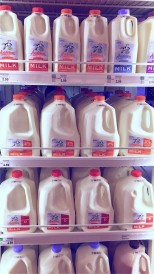Milk alternatives including almond, coconut and soy milk are gaining popularity and sales are on the rise from previous years. The Got-Milk campaign is still successful as many consume milk and milk products but times are changing.
Our grandparent’s generation were brought up to believe everyone should drink milk to get calcium and needed calories. “Then, things started to get complicated,” according to the editors at “Eat This, Not That,” a publication focused on nutrition. “First, it was skim, then 1 percent and 2 percent. Then cows started getting crowded off the shelves by almonds and soybeans, of all things. Why the move? Whether it’s because you’re vegan, sensitive to dairy, trying to lose weight, or jumping on the trend, more and more Americans are shying away from dairy products and embracing plant-based alternatives.”
According to EcoWatch, a leading environmental news site, some great alternatives to dairy milk include: soy, almond, rice, coconut, flax and hemp milks.
Soy milk is nutritionally equivalent to cow’s milk with calcium, vitamins A and D, riboflavin and protein.
Almond milk can be sweet and creamy and has a lot of vitamin E and yet is 1/3 of the calories of 2 percent milk. Rice milk is most hypoallergenic, free of soy, gluten and nuts and great for weight loss. Coconut milk resembles the texture of dairy milk and is known for its nutty flavor and it is soy and gluten free. Flax milk is high in fiber and ALA omegas, and can lower blood pressure and cholesterol. Lastly hemp milk is good for those allergic to soy, nuts and gluten and provides more iron than dairy milk, according to EcoWatch.
According to Dr. Denise Signorelli, professor of biological sciences at CSN, “Non-dairy alternatives can allow those who can’t drink dairy or don’t like dairy to get some of the essential nutrients found in dairy products. You want a non-dairy beverage to closely mimic dairy. Look for calcium supplementation, low sugar, reasonable amounts of proteins and other nutrients like Vitamin D.”
According to a study done by the University of Virginia titled “Moo-ove Over, Cow’s Milk: The Rise of Plant-Based Dairy Alternatives” it stated, “Worldwide sales of non-dairy milk alternatives more than doubled between 2009 and 2015, reaching $21 billion–a reflection of both consumer demand and the burgeoning array of products to meet that demand. Meanwhile, consumption of cow’s milk has dropped 13 percent in the United States over the last five years.”
Megan Hambleton, beverage analyst at Mintel Group Ltd, a market-intelligence agency, stated, “Innovation will be a catalyst to drive the category forward in 2018 as both mainstream bases like almond and alternative plant bases offer added functional benefits and unique flavors.” The sweetened and unsweetened vanilla and chocolate flavors are popular.
There are good reasons to go from dairy milk to the alternatives.
“Ever since I switched from dairy milk to almond milk I have felt that my digestive system has gotten stronger,” said Victoria Longoria, College of Southern Nevada student. “I have also realized that I have lost weight, so that’s a plus.”
 “I will admit that I will still drink dairy milk if it is in products like ice cream, donuts or cookies,” Longoria said. “Those are definitely my weakness.”
“I will admit that I will still drink dairy milk if it is in products like ice cream, donuts or cookies,” Longoria said. “Those are definitely my weakness.”
“I recently had to switch to a milk alternative because dairy milk was causing my body to have too much acid,” said Kevin Aguilar III, CSN student. “I was constantly getting sick until my doctor recommended that I try a milk alternative.” Aguilar is doing better now that he has.
Some have no plans to switch.
Angela Stoneback, CSN student, is accustomed to dairy milk because she grew up on it. “I drink dairy milk every day because I absolutely love it but ever since my mom went vegan I tried coconut milk and it wasn’t as bad as I had thought, flavor wise.”




